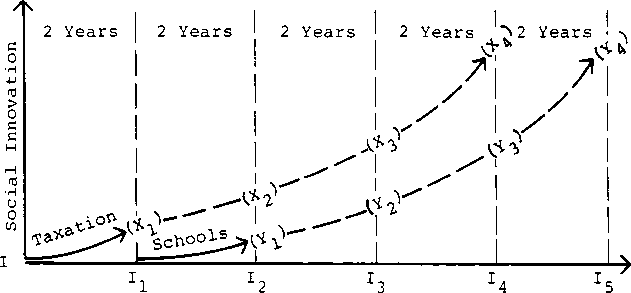S

Technological Innovation
Figure 4. Flow of Resources to New Research and
Educational Functions, Successive Stages
pointing eventually to goals Xn and Y∏ (Figure 4). These goals need
to be conceptualized originally only as broad functions of research
and education for institutional innovation to help direct resources
toward that capacity. Later experience will allow these goals to be
more specifically defined. Without that “capacity goal” of Xn and Yn,
the pull of the old technological function will reclaim resources in
short order.
Reconceptualization
One lesson learned from history is that, at some stage of process
and product development, men develop new concepts which apply to
what they are attempting to do (that is, from man flying like bird to
flying machine, from horseless carriage to automobile, from farmer
institutes to extension service, etc.) This process of bending old ideas
to new uses goes on constantly. Progress is slow at first and crude in
retrospect. However, at the point of reconceptualization, progress
accelerates rapidly.
Thus in Figure 5 in an indeterminate zone of time R, the university
system will reconceptualize its (Xi to Xn), (Yι to Yn), and Nth (all
other possible) functions, recasting and reorganizing itself to better
perform the social innovation function. The Nth functions represent
our other institutional systems whose improved performance is crit-
ical to man’s welfare. At the time of reconceptualization, resources
are then not further weaned from the old function but flow from out-
side sources to the new function. This becomes the time when “Hatch
22
More intriguing information
1. Quality practices, priorities and performance: an international study2. Public-private sector pay differentials in a devolved Scotland
3. El impacto espacial de las economías de aglomeración y su efecto sobre la estructura urbana.El caso de la industria en Barcelona, 1986-1996
4. The Prohibition of the Proposed Springer-ProSiebenSat.1-Merger: How much Economics in German Merger Control?
5. Global Excess Liquidity and House Prices - A VAR Analysis for OECD Countries
6. ¿Por qué se privatizan servicios en los municipios (pequeños)? Evidencia empírica sobre residuos sólidos y agua.
7. The Tangible Contribution of R&D Spending Foreign-Owned Plants to a Host Region: a Plant Level Study of the Irish Manufacturing Sector (1980-1996)
8. Estimated Open Economy New Keynesian Phillips Curves for the G7
9. Analyzing the Agricultural Trade Impacts of the Canada-Chile Free Trade Agreement
10. The name is absent